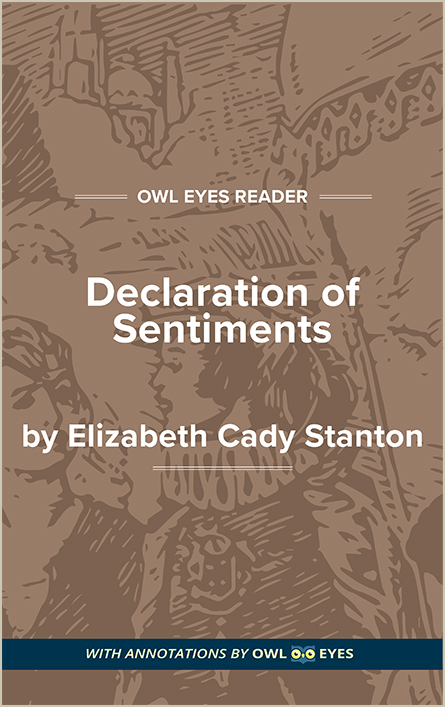Analysis Pages
Elizabeth Cady Stanton Biography
Elizabeth Cady Stanton is considered the mother of woman suffrage in the United States. Her father, Daniel Cady, was a federal judge, and Elizabeth spent many childhood hours listening to him interpret the law. Angered by the injustice of the law toward women, she vowed to work for changes. Having attended secondary school with her brothers to learn Latin, Greek, and algebra, she was astounded when refused admission to Union College on the basis of her sex. She attended Troy Female Seminary in Troy, New York, where she unhappily studied French, music, and dancing.
She spent the next seven years reading and studying law, painting, riding horses, and generally developing her mind and body. Disturbed by her own lack of purpose, she was heartened to meet Henry Brewster Stanton, the famous antislavery orator, journalist, and author. The injustice against which he fought for African American slaves she found similar to the inequality women faced under the law. Against family objections, she married Stanton and left immediately with him for England to attend the World’s Anti-Slavery Convention as delegates. There she met Lucretia Mott, the great Quaker women’s rights activist, and took up the banner officially for the cause of women’s equality.
The Stantons went home to Seneca Falls, New York. A year later, Stanton met with Mott and some of her Quaker friends to propose a convention for women at which the proper steps could be drawn up to improve their status. They called for women to attend a Women’s Rights Convention in the United States. It was in 1848 at the first convention in Seneca Falls Wesleyan Chapel that Stanton read her document called the “Declaration of Sentiments.” Based on the Declaration of Independence, it called for equality in all areas—education, economic issues, marriage property laws, and, for the first time in the history of the nation, the right to vote. The subject of suffrage drew fire from many protesters; however, after much debate, the declaration was signed by more than one hundred men and women, and the first official stance on suffrage for women was recorded. Two weeks later at a meeting in Rochester, New York, the document was again endorsed.
Stanton continued, along with Mott and others, to work toward women’s equality. Delivering speeches and writing articles were as much a part of her life as her family. In 1851, fortuitous circumstances brought Elizabeth Cady Stanton and Susan B. Anthony together, and an alliance was formed that lasted until Stanton’s death. Anthony’s work up to that point had mainly been in the area of temperance; however, she quickly added Stanton’s agenda to her own, and the two women steered the course of the fight for American women’s rights during the second half of the nineteenth century. Working together delivering speeches (with Susan helping Elizabeth with her seven children when Henry was in the legislature), leading protests, and banding with others to plead their cause in other cities, the two were formidable.
In 1854 Stanton was invited to address the joint judiciary committees of the New York legislature on the legal disabilities of women. Although the speech was warmly received, no laws were immediately effected. In 1869 the Fifteenth Amendment to the U.S. Constitution was ratified, removing all racial barriers to the right to vote. Despite activists’ efforts to include woman suffrage in the amendment, it had not been mentioned. That same year Stanton was elected president of the National Woman Suffrage Association, a post she held for twenty-one years. She and a group of women’s leaders drafted a proposal for a sixteenth amendment enfranchising women. The struggle was not to be over for many years; it was not until 1920 and the Nineteenth Amendment that all women in the United States were finally granted the right to vote. During the intervening years, the proposal became known as the Susan B. Anthony amendment because of Anthony’s...
(The entire page is 1,016 words.)
Owl Eyes subscribers get unlimited access to our expert annotations, analyses, and study guides on your favorite texts. Master the classics for less than $5/month!

